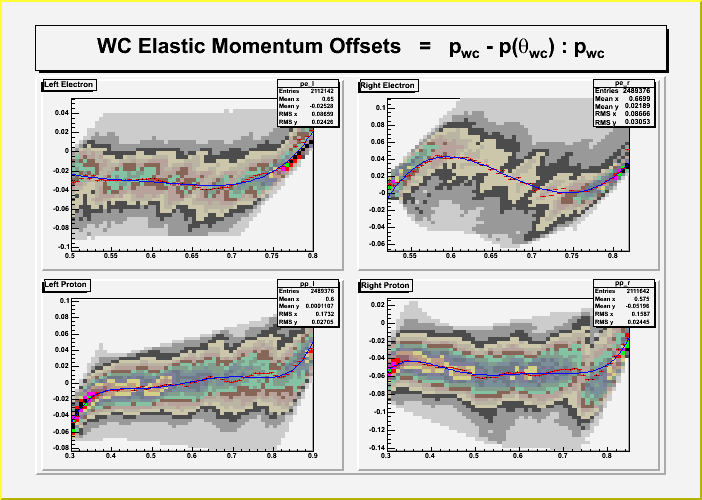Hi Michael,
Here are the plots that were promised. I included root files and the
source in the tgz file so you can do your own fits if you like. The
analytical fits for the momentum offsets are (note the negative definition):
left electron: p_wc - p(theta) = 5.12476e+00 + p * ( -3.45938e+01 +
p * ( 8.72022e+01 + p * ( -9.77085e+01 + p * ( 4.09917e+01 ))))
right electron: p_wc - p(theta) = -1.29173e+01 + p * ( 6.77607e+01 +
p * ( -1.28197e+02 + p * ( 1.02842e+02 + p * ( -2.90048e+01 ))))
left proton: p_wc - p(theta) = -2.78136e+00 + p * ( 2.51731e+01 +
p * ( -8.98231e+01 + p * ( 1.57192e+02 + p * ( -1.34683e+02 + p * (
4.52294e+01 )))))
right proton: p_wc - p(theta) = -2.41377e+00 + p * ( 2.31119e+01 +
p * ( -8.73933e+01 + p * ( 1.60497e+02 + p * ( -1.43912e+02 + p * (
5.06034e+01 )))))
The second plot shows that our Q^2 systematics for elastic kinematics
calculated from theta only are on the order of 0.01 GeV^2.
I didn't do the 'delta z:theta' plot. I realized that for the
elastic kinmatics, 'z_proton - z_electron' would be almost a constant
for all theta, but it would change sign for scattering in the opposite
sector.
--Chris
Michael Kohl wrote:
>Analysis meeting minutes:
>Attending EG, NM, TF, TA, DH, BT, AS, CC, MK.
>
>-"Big" Analysis meeting scheduled for Wednesday 4/61/2005
> (*not* Thursday!!)
>
>-EG:
> +Finds discrepancy for (e,e'n) yields from flr and dst for runs in
> the 8000's, however those still have no useful dst, only after
> recrunch. Should use new runs of this year instead which do have
> proper dst.
> +Reports (e,e'n) yields have decreased this year compared to last
> year because of lower target density (this may depend on particular
> run numbers), however relative to proton yield it is unchanged.
> +Should investigate if this also applies to the forward LADS wall
> (above Q2=0.4, or cut on L15), when normalizing (e,e'n) yields to the
> (e,e'p) rate in order to see if installing the lead
> shieldings/converters had any effect
> +Will get started with Tosca soon
>
>-TF:
> +Presenting inclusive-ep beam-target asymmetries compared to MC
> with MAID implemented.
> +Aleft and Aright for different trigger types, also A_TT' and A_TL'
> +Trigger type 7 agrees with MC
> +TF-MC and AS-MC agree
> +Trigger type 1 asymmetry is shifted to negative direction.
> Qualitative understanding is that the radiative tail of elastic
> scattering events contributes to the inclusive yield in the
> Delta-region, however only in trigger 1 and not in 2 (e,e'n) or 7
> (singles). Asymmetry attributed to elastic events is negative.
> Somewhat but not drastically different asymmetry of tail-events
> compared to unradiated events expected due to kinematics effect (q2
> different)
> +AS claiming that radiative tail does not explain quantitatively the
> discrepancy of measured asymmetry and MC.
> +In order to gain confidence into the implementation of MAID into
> BLASTMC, one needs some benchmarking. Possible checks are comparison
> of BLASTMC with MAID prediction for pointlike kinematics at prominent
> points (at top of Delta). MAID may not be the last word for
> polarization observables and the multipoles probed. The unpolarized
> case is much better known. Since the electron efficiency for
> inclusive scattering should be on the order of 80% and for a
> luminosity taken from ep elastic scattering, one could determine the
> differential cross section (unpolarized) to some limited precision
> which should be reproduced by MAID (dominant M1 multipole).
> +Different trigger types have different backgrounds; background may
> even be polarized as in above case. Polarized radiative-tail
> background should be handled in BLASTMC with MAID+radiation tail in
> generator.
>
>-NM:
> +Made MASCARAD to work, converted to C++ from Fortran. MASCARAD
> accounts for the Mo and Tsai radiative effects for elastic
> scattering including the helicity-dependent part.
>
>-We should have radiative effect in generator. May not be so important
> for asymmetries in elastic scattering, however it is important for
> the estimate of the contribution by radiated elastic events in the
> Delta region.
>
>-CC:
> +Showing ep elastic data and MC asymmetries and polarizations
> +Slight disagreement between MC and Hoehler-pointlike
> +Some cluster-like over-and undershooting of the Hoehler curve
> +Q2-dependence of PbPt gone after cutting more strictly on
> wirechamber hits. Data sample became smaller, polarization higher.
> +Kinematical corrections: Trust angles, calculate momenta from angles
> for elastic scattering -> p_exp-p_calc(the):the etc. for eleft,
> pright and vice versa. Seems to observe somewhat different results
> than EG (needs to be compared explicitly.)
> +p_exp-p_calc(theta):p_exp for eleft, pright, eright and p_left
> should be plotted and made available as a third set of kinematical
> corrections and be compared to the ones by AM and EG.
> +z_electron-z_proton is not zero and has opposite sign when sectors
> are flipped. Possible explanation may be a transverse offset of the
> target, beam, or wire chamber. If so, dz versus theta should cross
> zero at 90 degrees.
>
>Regards,
>
> Michael
>
>
>
>


This archive was generated by hypermail 2.1.2 : Mon Feb 24 2014 - 14:07:32 EST